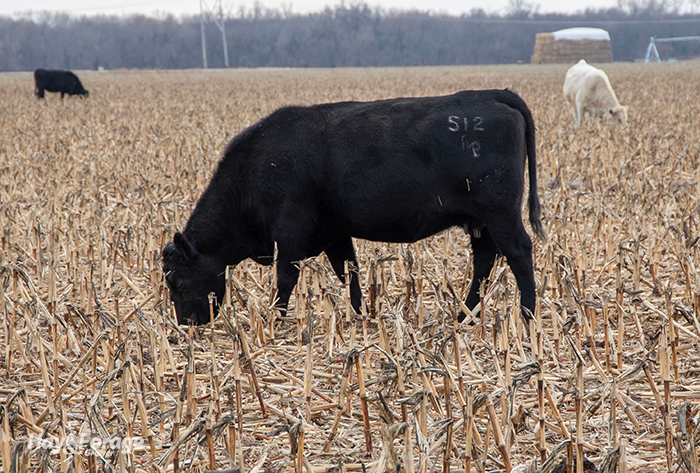
Cornstalks are an economical forage source to take advantage of for fall and winter grazing. Provided some supplementation, cattle can thrive on corn residue, and research has debunked previously held concerns about soil compaction, nutrient removal, and negative impacts on subsequent grain crop yields.
With that said, there are ways to optimize forage intake and improve the cost-effectiveness of cornstalk grazing. In a recent article from University of Nebraska Extension, Ben Berger shares three keys to successfully utilize corn residue for livestock feed.
Scout fields first. “Scouting fields before grazing is important to determine the amount of corn present and to look for spilled corn that could cause grain overload, possibly resulting in bloat or death,” the extension beef specialist writes. If there are more than 8 to 10 bushels per acre of corn grain left on the ground, farmers need to manage animal intake by implementing a controlled grazing strategy.
Strip grazing will reduce the risk of grain overload by giving animals limited access to a portion of the field. This will also discourage selective grazing since cattle tend to seek out higher quality components of the corn plant — grain, husks, and leaves — before eating less digestible cobs and stalks. Rotate the herd quickly through these strip-grazed paddocks to further prevent grain overload.
Calculate grazing days per acre. Berger suggests farmers use the University of Nebraska-Lincoln’s cornstalk grazing calculator to determine the length of the grazing period based on their corn yield and average animal weight.
The extension beef specialist also offers a quick reference equation to estimate grazing days per acre available for one 1,200-pound, nonlactating cow: Take average corn yield divided by 3.5. For example, an average corn yield of 180 bushels per acre would provide roughly 51 grazing days per acre for a cow of that size.
Supplement cattle as needed. Corn residue quality declines over time. Although this depends on stocking rate, moisture, and overall field conditions, it’s best to turn the herd out on harvested cornfields sooner than later. Moreover, cattle can graze cornstalks through a few inches of snow, but they won’t be able to graze corn residue through ice.
Berger states mature, nonlactating cows in good body condition don’t need supplemental protein while grazing cornstalks, but farmers should offer salt, minerals, and vitamins to ensure these cows meet their nutrient needs.
On the other hand, first-calf heifers within 90 days of calving and fall-calving cows will require extra protein and energy. Berger suggests farmers feed dried distillers grains at a rate of 3.5 pounds per head per day for heifers and 5 pounds per head per day for fall-calving cows. Weaned calves will benefit from added protein and energy while grazing cornstalks, too. Berger says 2 pounds of dried distillers grains per head per day can help calves reach a targeted 1-pound average daily gain.

